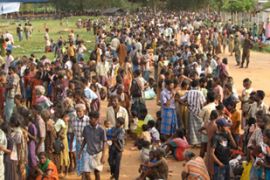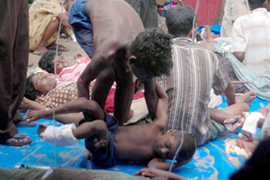Sri Lankans flee ‘hellish’ war zone
Distressed escapees say they were shot at by LTTE as fears for civilians’ plight rises.

“I’ve been talking to the Tamils about the conditions they have been in – they described them as ‘hellish’.”
‘Rescue operations’
The Sri Lankan military says its so-called hostage-rescue operations are continuing.
Brigadier Udaya Nanayakkara, a Sri Lankan military spokesman, told Al Jazeera that the army “rescued” 40,000 civilians from the northern conflict zone on Wednesday alone.
| Focus: Sri Lanka | ||||||||||

|
“We are conducting hostage rescue operations, and up till now 100,000 hostages have been rescued by army troops since the 20th of this month,” he said.
“They have been evacuated to welfare camps located in one area.”
Officials also said Velayutham Dayanithi, the LTTE’s former media spokesman, whose nom de guerre is Daya Master, and an interpreter for group’s political wing, known only as George, turned themselves over to government forces on Wednesday.
The war zone of about 21sq km has been split into two sections by the army, our correspondent said.
A Tamil website reported on Wednesday that the Sri Lankan military fired cannons towards a coastal area where the International Committee of the Red Cross (ICRC) was preparing to take injured civilians away from the conflict zone.
Checking for weapons
The LTTE defied a government ultimatum that expired at noon (06:30 GMT) on Tuesday to give up or face a “final assault”, saying they will not surrender.
The warning forced tens of thousands of civilians to escape from the conflict zone.
Mahinda Samarasinghe, Sri Lanka’s minister for disaster management and human rights, told Al Jazeera that the civilians are being checked for weapons and are then handed over to a government agency that looks after them in the various camps.
| In video | ||
|
However, humanitarian organisations have conveyed fears for civilians both inside the war zone and those who have fled the area.
The ICRC said on Tuesday that about 50,000 people were still stranded in the tiny strip of land in the island’s northeast, and a final offensive “could lead to a dramatic increase in the number of civilian casualties”.
“The situation is nothing short of catastrophic,” Pierre Kraehenbuehl, the ICRC operations director in Sri Lanka, said.
“Ongoing fighting has killed or wounded hundreds of civilians who have only minimal access to medical care.
“I cannot remember … as much concentrated pain and exposure to violence with very, very minimal possibilities to reach anywhere that could be called safe.”
‘Blast injuries’
Dr Ghana Gunalan, director of health services, at Trincomalee on the northeast coast, told Al Jazeera: “Most of these [refugees] have been transported under ICRC flags to Trincomalee. Most people have blast injuries, including to their limbs and abdomens.
“[These injuries] must have been caused by flying objects that have exploded in front of them.”
Samarasinghe said that the government was trying to help those taken into camps.
 |
| Humanitarian groups have expressed concern for refugees in government camps [AFP] |
“Admittedly, it is not five-star accommodation, but we are trying very hard. There are areas for improvement and we are working on them very consciously,” he said.
The UK and France have said that they will try to launch relief operations to civilians fleeing the fighting.
The UN, which estimates that more than 4,500 civilians have been killed in the past three months, has been one of a number of voices calling for a negotiated truce to allow civilians to leave the rebel-held coastal strip.
Reports had surfaced on Monday of about 1,000 civilians being killed in the war zone due to the fighting. The government denied the deaths, saying that 17 civilians had died due to LTTE shelling and three suicide bombings.
The Sri Lankan government has barred independent journalists from entering the war zone.
The LTTE has been fighting for a separate homeland in the north for the country’s Tamil minority for 26 years.

